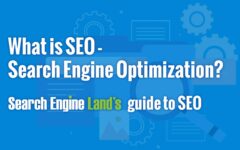How to do SEO for my website
January 24, 2024 2024-01-25 5:43How to do SEO for my website
How to do SEO for my website In the vast digital landscape, having a website is no longer enough; it must be easily discoverable by search engines to attract a substantial audience. Search Engine Optimization (SEO) is the key to achieving this visibility and driving organic traffic to your website. This comprehensive guide will walk you through, How to do SEO for my website.
How to do SEO for my website
Understanding what is SEO:
Search Engine Optimization (SEO) is a crucial digital marketing strategy designed to enhance a website’s visibility and ranking on SEO. How to do SEO for my website .In essence, SEO aims to optimize a website’s content, structure, and overall online presence to make it more attractive to search engines like Google, Bing, and Yahoo. This helps to understand how to do SEO for my own website.
At its core, SEO revolves around the concept of understanding and meeting the criteria that search engines use to rank web pages. The primary goal is to ensure that a website appears among the top results when users search for relevant keywords or phrases. This increased visibility can lead to higher organic (non-paid) traffic.
SEO encompasses a wide range of techniques, both on-page and off-page, to improve a website’s search engine ranking. On-page SEO involves optimizing individual pages by focusing on factors such as keyword placement, content quality, Meta tags, and multimedia elements.

Off-page SEO, on the other hand, involves activities outside the website, like link-building, social media signals, and online reputation management.
Search engines employ sophisticated algorithms that consider various factors to determine a webpage’s relevance and authority. Keywords play a pivotal role, as search engines analyse how well a webpage’s content aligns with user queries. Quality and relevance of content, site speed, mobile-friendliness, and overall user experience are also critical factors influencing search rankings. This helps to understand how to do SEO for my own website, SEO practices must adapt to stay effective. Voice search, mobile-first indexing, and algorithm updates are just a few examples of the dynamic landscape that SEO professionals navigate. In the rapidly changing world of online search, staying informed about industry trends and adhering to best practices is essential for businesses and website owners looking to maximize their online visibility and reach their target audience effectively. Basically having knowledge of SEO, help us better know, how to do SEO for our own website.
Some of the Factor consider for SEO are:
- Keyword Research
- On-Page SEO
- Technical SEO
- Off-Page SEO
- Content Creation and Optimization
- Local SEO
- User Experience and SEO
- Analytics and Monitoring
Keyword Research
Keyword research is a foundational element of any successful Search Engine Optimization (SEO) strategy, playing a pivotal role in enhancing a website’s visibility and attracting the right audience. It involves identifying and targeting specific terms or phrases that users are likely to use when searching for information related to a particular topic or industry.
The importance of How to do SEO for my website keyword research lies in its ability to align website content with the terms that potential visitors are using in search engines. By understanding the language of the target audience, businesses can create relevant and valuable content, improving the chances of their website appearing in search results.
Several tools are available to aid in keyword research, competition, and related terms. Popular tools include Google Keyword Planner, SEMrush, Keyword Magic Tool, Ahrefs, and Moz Keyword Explorer. These tools help businesses identify high-performing keywords, allowing them to prioritize content creation and optimization efforts effectively.

Competitor analysis is another integral aspect of keyword research. Understanding what keywords competitors are targeting can provide valuable insights and uncover opportunities for improvement. Analysing competitor strategies helps businesses identify gaps in their own content, discover niche keywords, and adapt their approach to stay competitive in the online landscape. All of this helps in understand how to do SEO for my website.
When conducting keyword research, one must consider the distinction between long-tail and short-tail keywords. Short-tail keywords are broad terms with high search volumes, while long-tail keywords are more specific and have lower search volumes. While short-tail keywords may generate more traffic, long-tail keywords often lead to higher conversion rates. Striking a balance between the two and incorporating a mix of short and long-tail keywords in a content strategy can optimize a website for both visibility and relevance. Because of having knowledge of SEO, it help us better to know, how to do SEO for our own website.
On Page SEO
On-page SEO involves optimizing individual web pages to improve their search engine rankings and attract organic traffic. Several key elements contribute to a well-optimized page, including the title tag, URL structure, header tags, keyword placement and density, image optimization, and internal linking.
The title tag is a crucial on-page SEO element that provides a concise and relevant description of the page’s content. It appears as the main clickable link in search engine results, influencing click-through rates and search rankings. Including primary keywords in the title tag is essential for signaling the page’s relevance to search engines and users.
URL structure is another important aspect of on-page SEO. Including relevant keywords in the URL can further enhance the page’s visibility and SEO performance. Header tags (H1, H2, H3, etc.) provide a hierarchical structure to the content on a page. Properly using header tags not only improves content readability but also signals the importance and relevance of different sections to search engines

Strategic keyword placement and density are crucial for on-page SEO. Incorporating relevant keywords naturally within the content, especially in the first paragraph, Meta description, and subheadings, helps search engines understand the page’s focus.
Image optimization involves using descriptive file names, alt text, and captions for images. This not only improves accessibility for users with disabilities but also provides additional opportunities for keyword relevance. Compressing images to reduce file size contributes to faster page loading, positively impacting both user experience and search rankings.
Internal linking is the practice of linking to other pages within the same website. This helps distribute link equity, enhances navigation for users, and establishes a hierarchical structure for the site.
Though effective on-page SEO involves optimizing various elements such as title tags, URL structure, header tags, keyword placement, image optimization, and internal linking. By paying attention to these details, one can easily understand how to do SEO for own website.
TECHNICAL SEO
Technical SEO focuses on optimizing the technical aspects of a website to improve its search engine performance. Several key elements contribute to effective technical SEO, including website speed, mobile optimization, XML sitemaps, and canonical tags.
Website speed is a critical factor in SEO, as search engines consider page loading times when ranking websites. Slow-loading pages can lead to a poor user experience and negatively impact search rankings. Optimizing images, leveraging browser caching, and reducing unnecessary scripts are common strategies to enhance website speed. Fast-loading pages not only straightaway improve user satisfaction but also contribute to higher search engine rankings.
Mobile optimization is another crucial aspect of technical SEO, given the increasing prevalence of mobile device usage. Search engines prioritize mobile-friendly websites, and mobile responsiveness is a ranking factor. Ensuring that a website is accessible and functions seamlessly on various devices enhances user experience and improves search engine visibility.

XML sitemaps play a vital role in helping search engines understand the structure and organization of a website. These sitemaps provide a roadmap of all the important pages on a site, making it easier for search engine crawlers to index content. Regularly updating and submitting XML sitemaps can ensure that search engines discover new content promptly.
Canonical tags are used to address duplicate content issues on a website. When multiple URLs lead to similar or identical content .Significantly this helps search engines understand which version to prioritize in search results, preventing potential issues with duplicate content penalties.
Incorporating technical SEO elements collectively contributes to a website’s overall health and search engine visibility. By prioritizing this you are more likely to improve the likelihood of higher rankings in search engine results pages Implementing these technical optimizations is not only beneficial for SEO but also for providing a seamless and efficient experience for visitors to the site.
OFF –Page SEO
Off-page SEO is a crucial aspect of optimizing your website’s visibility and authority on search engines. It involves activities outside your website that impact its ranking. Here are some key strategies within off-page SEO
Backlink Building links from external websites to your site, signaling its credibility to search engines. Quality backlinks from authoritative sources play a significant role in boosting your website’s search engine rankings. Focus on building a diverse and natural backlink profile by obtaining links from reputable websites in your industry. Guest posting, influencer collaboration, and social media promotion are effective methods for acquiring valuable backlinks.
Influencer Collaboration, Partnering with influencers in your industry can help you tap into their existing audience and gain exposure. Influencers often have a substantial following, and when they endorse or share your content, it can lead to increased visibility and credibility. Collaborate with influencers whose audience aligns with your target demographic to maximize the impact of this strategy.

Guest Posting, contributing high-quality content to other websites in your niche through guest posting is an excellent way to build backlinks and establish your authority. Identify reputable websites that accept guest posts and create valuable, relevant content that provides value to their audience. In return, you can include a link back to your site in the author bio or within the content, boosting your website’s authority and visibility.
Online Management Reputation managing your online reputation is crucial for establishing trust and credibility. Monitor online reviews, engage with your audience on social media, and address any negative feedback promptly. Positive online reviews and a strong social media presence contribute to a positive brand image, which, in turn, can positively impact your search engine rankings.
In conclusion, off-page SEO is a multifaceted approach that involves building a strong online presence through backlink building, influencer collaboration, guest posting, and effective online reputation management. By incorporating these strategies, you can enhance your website’s authority, visibility, and overall search engine performance.
Content Creation and Optimization
Content creation and optimization are integral components of a successful digital marketing strategy. Quality content not only attracts and engages your audience but also plays a pivotal role in search engine optimization. Here are key aspects to consider in content creation and optimization
Importance of Quality Content: High-quality content is the foundation of a successful online presence. Search engines prioritize content that provides value to users. Obviously ,Well-researched, informative, and relevant content not only attracts your target audience but also encourages them to stay on your site longer. Quality content rather establishes your expertise, indeed builds trust, and likewise increases the likelihood of users meanwhile engaging with your brand.
Creating Length and Formatting: The length of your content matters, but it should be dictated by the value it provides rather than an arbitrary word count. Long-form content often performs well as it allows for in-depth exploration of topics, demonstrating expertise.

However, ensure that your content is well-formatted with subheadings, bullet points, and concise paragraphs to enhance readability. This not only improves the user experience but This helps to know how to do SEO of my own Website
Regular Content Update: Search engines favor websites that regularly update their content. Periodically revisit and refresh existing content to ensure it remains accurate and relevant. Additionally, consistently publishing new content signals to search engines that your site is active and authoritative. Consider creating a content calendar to plan and schedule regular updates earlier , keeping your audience engaged and informed.
In conclusion finally, content creation and optimization are essential for digital success. Quality content, engagement factors, appropriate length, and regular updates contribute to a strong online presence, improved search engine rankings, and increased audience engagement. Prioritize these elements to ensure your content effectively serves both your audience and search engine algorithms.
Local SEO
Local SEO is crucial for businesses aiming to enhance their visibility in specific geographic areas. This helps to know how to do SEO of my own Website. Despite to achieve success, focus on optimizing key elements that directly impact local search rankings
Google My Business is a powerful tool for local businesses. Optimize your GMB listing by providing accurate and up-to-date information, including your business name, address, phone number, business hours, and categories. Regularly update your GMB profile with posts, events, and promotions to keep your audience informed.
NAP (Name, Address, Phone Number) consistency is crucial for local SEO. Ensure that your business information is consistent across all online platforms, directories, and your website. Any discrepancies can confuse search engines and potential customers. Regularly audit and update your business information to maintain accuracy. Ensure that your business information is consistent across all online platforms, directories, and your website.

Local citations refer to online mentions of your business, typically in local directories, websites, or platforms. Consistent and accurate citations contribute to your business’s authority and trustworthiness in the eyes of search engines. Identify reputable local directories, industry-specific platforms, and citation sources to list your business. Keep the information uniform across all platforms to strengthen your local SEO efforts.
Customer Review and Rating: Positive customer reviews and high ratings not only influence potential customers but also play a role in local search rankings. Comparatively, encourage satisfied customers to leave reviews on your GMB profile and other relevant review platforms.
In conclusion, local SEO is a dynamic and critical aspect for businesses targeting local audiences. Google My Business optimization, NAP consistency, local citations, and customer reviews collectively contribute to a robust local SEO strategy. By focusing on these elements, businesses can enhance their visibility in local search results and attract a geographically relevant audience.
User Experience and SEO
User Experience (UX) and SEO are intricately connected, as search engines prioritize delivering the best possible experience to users. This helps to know how to do SEO of my own Website Here are key factors to consider in the intersection of UX and SEO:
Website Design and Navigation: A well-designed and user-friendly website is essential for both users and search engines. Structured menus, logical page hierarchy, and a consistent design contribute to a positive user experience. Search engines reward websites with intuitive navigation by ranking them higher in search results. Beside How to do SEO for own website.
Mobile Responsiveness: With a growing number of users accessing the internet via mobile devices, mobile responsiveness is critical for both UX and SEO. Google prioritizes mobile-friendly websites in its search rankings. Ensure that your website is optimized for various screen sizes, providing a seamless experience across desktops, tablets, and smartphones. A mobile-friendly site not only satisfies users.

Page Layout and Readability: An organized and visually appealing page layout enhances the overall user experience. Use clear headings, subheadings, and concise paragraphs to improve readability. Break up content with images, . User-friendly content not only keeps visitors engaged but also contributes to better SEO, as search engines recognize well-structured and readable content.
Reduce Bounce Rate: Bounce rate, the percentage of visitors who navigate away from a site after viewing only one page, is a crucial metric for both UX and SEO. To reduce bounce rate, ensure before that your website loads quickly, content is relevant, and calls to action are clear.
In conclusion, seamless integration of UX principles with SEO best practices is vital for online success. By focusing on website design and navigation, mobile responsiveness, page layout, and reducing bounce rate, you can create a positive user experience that aligns with search engine algorithms, ultimately improving your website’s visibility and rankings.
Analytics and Monitoring
Analytics and monitoring play a pivotal role in the success of any online strategy, providing valuable insights that help refine and optimize performance. Here are key aspects of analytics and monitoring, including the setup of Google Analytics, monitoring KPIs, and adjusting strategies based on data:
Setting up Google Analytics: Google Analytics is a powerful tool that provides comprehensive data on website performance. Additionally, to set it up, create a Google Analytics account, add your website, and install the tracking code on your site.
Monitoring key performance indicators (KPIs): Identifying and tracking key performance indicators is essential for evaluating the success of your online efforts. KPIs can vary based on business goals but often include metrics such as website traffic, conversion rates, bounce rates, and user engagement. Regularly monitor these KPIs to assess the effectiveness of your strategies. Analyzing the data allows you to identify trends, strengths, and areas that require improvement.

Adjusting strategies based on analytics data: Analytics data serves as a guide for refining and adjusting your online strategies. Conversely, if a specific marketing channel is driving significant traffic and conversions, allocating more resources to that channel may be beneficial. Regularly review analytics reports to identify patterns and anomalies, enabling you to make informed decisions to enhance overall performance.
Continues Improvement and Optimization: The real power of analytics lies in its ability to inform continuous improvement. . By consistently analysing data and making data-driven adjustments, you can optimize your online presence for maximum impact and ROI. Accordingly, Tips to How to do SEO for own website.
In conclusion, analytics and monitoring are essential components of a successful online strategy. Setting up Google Analytics, monitoring KPIs, and adjusting strategies based on analytics data enable businesses to make informed decisions, refine their approaches, and ultimately achieve better results in the dynamic digital landscape.
Future Trends in SEO
The future of SEO is evolving rapidly with advancements in technology and changing user behaviors. Several trends are shaping the landscape, influencing the way businesses optimize their online presence:
Voice search optimization: The rise of voice-activated devices and virtual assistants has led to a surge in voice searches. Optimizing for natural language queries and conversational content is becoming increasingly important. SEO strategies must adapt to address user intent in voice searches, which often differ from traditional text-based searches.
Artificial intelligence and machine learning: AI and machine learning are transforming the way search engines evaluate and rank content. Search algorithms are becoming more sophisticated in understanding context, user behavior, and content relevance. Businesses need to leverage AI tools for data analysis, content generation, and personalized user experiences to stay ahead in the competitive SEO landscape.
Video SEO: Video content continues to gain prominence, and search engines are placing more emphasis on it.

Optimizing video content for search engines involves using descriptive titles, detailed video descriptions, relevant tags, and creating engaging content that keeps viewers on the page.
Core Web Vitals and Page Experience: Google’s Core Web Vitals focus on user experience metrics, such as loading speed, interactivity, and visual stability. Providing a seamless and fast web experience is not just about ranking higher but also about meeting user expectations..
As businesses navigate the ever-changing landscape of SEO, staying abreast of these trends is crucial. Integrating voice search optimization, embracing AI and machine learning, prioritizing video SEO, and focusing on Core Web Vitals will be essential for maintaining a competitive edge.
Conclusion: Search Engine Optimization is an ongoing process that requires dedication, time, and a comprehensive understanding of the ever-evolving landscape. By implementing the strategies outlined in this guide, you can helps to know how to do SEO of my own Website, and ultimately achieve success in the competitive online environment.







